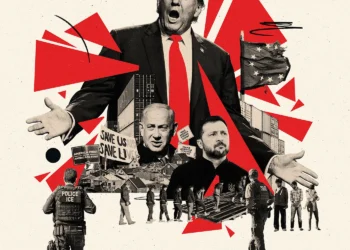India’s Finance Secretary Ajay Seth has raised an early red flag over the potential impact of recently announced U.S. tariffs on Indian exports, warning that the trade measures could shave up to 0.5 percentage points off India’s GDP growth in the current fiscal year. The remarks, delivered during a panel discussion at the Hudson Institute on the sidelines of the Spring Meetings of the International Monetary Fund (IMF) and World Bank, mark the government’s first formal assessment of the economic fallout.
“If these tariffs stay in place for a sustained period, they could trim between 0.2% to 0.5% off our projected GDP growth,” Seth cautioned, citing early models from the finance ministry’s research wing. India had earlier projected GDP growth of around 6.5% for FY25.
Immediate Economic Ripples
While exact sectoral breakdowns are still being studied, analysts agree the impact will be unevenly felt across India’s export landscape. Sectors such as metals, pharmaceuticals, chemicals, automobiles, jewellery, and processed foods are seen as most vulnerable to retaliatory tariffs or import substitution by American buyers.
A report by Citi Research estimates that India could lose as much as $7 billion annually in export earnings if the tariff schedule is fully implemented without exemptions. “Even marginal erosion in export competitiveness can trigger cascading effects in employment and downstream industries,” noted a senior economist at Citi.
Meanwhile, Goldman Sachs has projected a potential drag of 0.1% to 0.3% on India’s GDP growth depending on how long the tariff regime persists and whether trade tensions escalate.
Trade Negotiations Underway
In response to the escalating trade challenge, India is pushing ahead with efforts to secure a bilateral trade agreement with the United States. Finance Minister Nirmala Sitharaman expressed optimism last week that the first phase of the pact could be concluded by autumn, providing clarity and stability for exporters and investors alike.
The diplomatic urgency was echoed by U.S. Vice President JD Vance during his recent visit to India. Vance described the relationship as “central to the stability of the 21st-century global economy” and urged for rapid progress in trade talks.
Sources within India’s Ministry of Commerce confirmed that both countries have agreed on a terms of reference framework and are in advanced talks around tariff relaxations, market access for services, and digital trade norms.
Sector-Specific Adjustments
While some industries brace for headwinds, others may stand to gain amid shifting global dynamics. For instance, Indian agricultural exports like basmati rice and seafood may remain competitive due to higher tariffs imposed on regional competitors like Vietnam and Thailand.
“There’s scope for tactical realignment in trade portfolios,” said a senior official at the Federation of Indian Export Organisations (FIEO). “But that requires swift policy moves, incentives for value-added production, and aggressive market diversification.”
India’s services exports, particularly in IT and financial consulting, remain unaffected for now and continue to act as a key cushion in balancing the current account.
Broader Economic Outlook
The World Bank this week lowered India’s GDP growth forecast from 6.7% to 6.3%, citing global economic uncertainty, rising interest rates in developed markets, and weakening trade momentum.
Despite these concerns, India continues to demonstrate resilience. Retail inflation has eased to a five-year low, and a better-than-average monsoon outlook could boost rural demand and food supply, providing internal support to the economy. These factors could also prompt the Reserve Bank of India to consider rate cuts in the second half of the fiscal year, offering monetary stimulus in a globally tightening environment.
Looking Ahead
As India navigates its position amid fracturing global trade dynamics, the challenge is clear: shield domestic growth from external shocks without compromising competitiveness or diplomatic relationships.
Finance Secretary Seth’s warning is a sober reminder of the complex balancing act ahead. The next few months will test not only the strength of India’s economy but also its agility in reshaping global partnerships and safeguarding long-term growth trajectories.
With trade negotiations underway and contingency strategies in motion, India is preparing for a measured yet firm response—one that keeps the country’s growth engine running even as external crosswinds gather pace.











